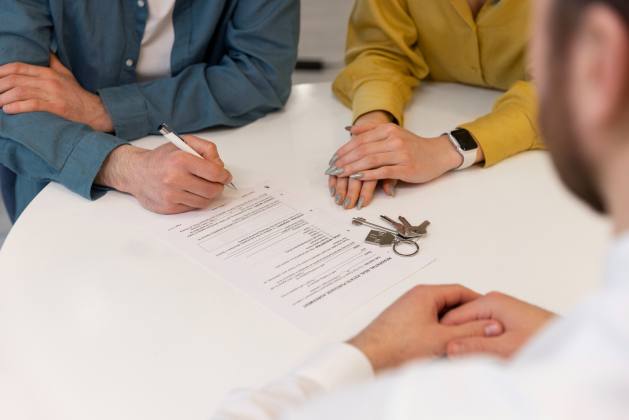Understanding Lease Language for Maintenance and Repairs

Specializes in providing actionable insights into the commercial real estate space for investors, brokers, lessors, and lessees. He covers quarterly market data reports, investment strategies, how-to guides, and top-down perspectives on market movements.

Leasing commercial real estate can be an exciting time for businesses expanding or relocating. However, amidst the thrill of finding the perfect location and negotiating rent, a crucial aspect often gets overlooked: understanding the lease language surrounding maintenance and repairs.
This seemingly mundane detail can become a major headache down the road if not clearly defined. A leaky faucet might turn into a plumbing nightmare, and a flickering light could snowball into an electrical fiasco, depending on who's responsible for fixing it.
Here, we'll illuminate the often-murky waters of lease language regarding maintenance and repairs in commercial real estate.
We'll delve into key terms, explore different scenarios, and equip you with valuable tips to negotiate a clear and concise maintenance clause in your lease agreement.
Understanding Key Terminology
Before we dive deeper, let's establish a common understanding of some key terms you will encounter in your lease:
- Landlord: The owner of the commercial property who is leasing the space to your business.
- Tenant: Your business entity that is leasing the commercial space from the landlord.
- Premises: The specific commercial space you are leasing, including the building, fixtures, and common areas (if applicable).
- Reasonable Wear and Tear: The natural deterioration of the premises due to everyday use.
- Maintenance: Activities intended to keep the premises in good working order, preventing future problems.
- Repair: The act of fixing or restoring something that is broken or damaged.
These are just a few of the most important terms you'll encounter in your lease. Some others you might see may include rent abatement and tenant improvement allowance.
Who's Responsible for What?
The lease will typically outline the responsibilities of both the landlord and the tenant regarding maintenance and repairs.
Here's a breakdown of some common scenarios.
Landlord's Responsibilities
Generally, the landlord is responsible for maintaining the overall structure and functionality of the building.
This includes:
- Roof & Exterior Walls: Ensuring their integrity to prevent leaks, damage from weather elements, etc.
- HVAC System: Maintaining proper functioning of heating, ventilation, and air conditioning.
- Plumbing System: Ensuring water supply, drainage, and addressing leaks or clogs in main lines.
- Electrical System: Maintaining the building's electrical wiring, outlets, and ensuring safe operation.
- Common Areas: Upkeep of elevators, hallways, restrooms, parking lots (if applicable) in common areas.
Now, let's take a look at what tenant responsibilities usually are.
Tenant's Responsibilities
The tenant is responsible for maintaining the leased space itself and for any damage it causes beyond "reasonable wear and tear."
Examples include:
- Interior Walls and Flooring: Maintaining cleanliness and addressing minor repairs like nail holes or chipped paint.
- Fixtures: Maintaining sinks, toilets, faucets, cabinets, and any built-in appliances within the space.
- HVAC Controls: Ensuring proper temperature settings and not exceeding reasonable usage.
- Minor Electrical Issues: Replacing burnt-out light bulbs or loose switches.
- Trash Removal: Keeping the leased space free of garbage and disposing of it appropriately.
Next, let's define exactly what “reasonable wear and tear” means and how its definition applies to you as a tenant.
Decoding "Reasonable Wear and Tear"
Defining "reasonable wear and tear" is crucial. While a faded carpet from foot traffic falls under this category, damage caused by heavy machinery or spills would not.
Here are some tips:
- Consult Industry Standards: Look for industry standards related to the type of commercial space you're leasing. This can help establish a baseline for what constitutes "reasonable wear and tear."
- Document Everything: Take pictures and document the condition of the premises when you move in. This will serve as a reference point in case of disputes later.
- Specificity Is Key: Negotiate a clear definition of "reasonable wear and tear" in your lease. Be specific about items like carpet wear, paint fading, and minor electrical issues.
But how do you negotiate a maintenance clause that's equally beneficial for both parties? Let's take a look at how to do just that.
Negotiating Your Maintenance Clause
Now that you understand the core areas of responsibility, it's time to tackle negotiating your maintenance clause:
- Response Time: Negotiate a reasonable timeframe for the landlord to respond to your maintenance requests. This timeframe should be specific to the type of issue (e.g., immediate response for emergencies like a water leak).
- Emergency Repairs: Ensure the lease clarifies who bears the cost of emergency repairs caused by unforeseen breakdowns (e.g., a burst pipe or a major electrical outage).
- Access for Repairs: Establish clear guidelines on the landlord's access to the premises for repairs. This could involve scheduling access during business hours or offering notice periods.
- Tenant Improvements: If you plan to make any modifications to the space (e.g., installing new fixtures), clarify if you'll be responsible for maintaining these improvements upon lease termination.
- Preventative Maintenance: Explore the possibility of including language that encourages the landlord to perform preventative maintenance on critical systems like HVAC or plumbing.
Finally, understand the consequences of neglecting your maintenance responsibilities as a tenant. The lease might outline procedures for rectifying the issue or potential termination of the lease agreement.
Beyond the Basics: Additional Considerations
While the core areas of responsibility and negotiation tips provide a solid foundation, here are some additional considerations for a comprehensive maintenance clause:
- Subleasing: If you plan to sublease any portion of your space, clarify whether the maintenance responsibilities for that area fall on you or the subtenant.
- Accessibility Compliance: Ensure the lease addresses the responsibility for maintaining accessibility features like ramps, elevators, and handicap-accessible restrooms.
- Environmental Issues: Inquire about the presence of asbestos, lead paint, or other potential environmental hazards, and clarify who is responsible for remediation if necessary.
- Inspections: Negotiate the frequency and scope of property inspections by the landlord. This ensures both parties can verify the condition of the premises.
Commercial leases can be complex documents. Don't hesitate to seek help from a qualified commercial real estate attorney who can review your lease and guide you through the negotiation process of the maintenance clause.
An attorney can ensure the language is clear, concise, and protects your business's interests by:
- Identifying Potential Loopholes: A lawyer can spot ambiguities in the lease language that could lead to future disputes.
- Negotiating Favorable Terms: An attorney with experience in commercial lease negotiations can advocate for your needs and secure a fair allocation of maintenance responsibilities.
- Understanding Local Laws: Commercial real estate regulations can vary by location. A lawyer can ensure your lease aligns with relevant local ordinances.
By understanding key terms, common scenarios, and negotiation strategies, you can approach the maintenance and repair clause in your commercial lease agreement with confidence. Remember, clear and concise communication is key.
Don't be afraid to ask questions and negotiate for a clause that reflects a fair and responsible approach to maintaining the leased space.
With a little effort upfront, you can avoid potential headaches and ensure a smooth and successful occupancy of your new commercial space.
Win Commercial Projects & Outperform Your Competitors by Knowing What's Happening in Your Area
MyEListing.com provides commercial vendors looking for new projects with up-to-date market intelligence on which commercial property owners need construction work, when they need it, and where they need it.
Make finding new commercial real estate projects easier than ever with MyEListing's Vendor Client Connection Program.
Article Search
Share
All Article Categories








